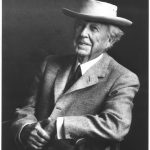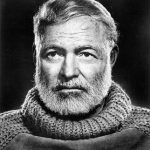Ernest Hemingway was born in Oak Park, Illinois. Frank Lloyd Wright lived there. And so did I.
Oak Park is a vintage suburb of Chicago that retains a small-town atmosphere despite a population of 50,000. Century-old buildings and tree-lined streets give it a sense of history. Hemingway once described Oak Park as a town of broad lawns and narrow minds. In recent years it’s become trendy but still is best known for two of its most famous residents.
Another Oak Park native, comedian Judy Tenuta, quipped that Oak Park was about sitting on uncomfortable chairs to shoot moose.
When I was in high school in the late 1950s these legends were still making news. Hemingway had published The Old Man and the Sea in 1952 and was basking in the celebrity of his Nobel Prize for literature in 1954. Wright, at age 89, unveiled a plan for a mile-high building in downtown Chicago in 1956.
 Wright settled in Oak Park when he was starting out as an architect and built 25 structures there between 1889 and 1913. Some did not have his distinctive rectilinear style because when Wright was young and hungry he sometimes built what the client wanted. Picture FLW gritting his teeth as he says, “So you want gingerbread trim on the eaves? Okey-dokey.”
Wright settled in Oak Park when he was starting out as an architect and built 25 structures there between 1889 and 1913. Some did not have his distinctive rectilinear style because when Wright was young and hungry he sometimes built what the client wanted. Picture FLW gritting his teeth as he says, “So you want gingerbread trim on the eaves? Okey-dokey.”
By the 1950s the Frank Lloyd Wright houses were local curiosities that attracted architecture students with cameras. I found Wright’s buildings and his rebellious persona interesting and read his weighty autobiography.
When the Navy sent me to Japan I visited Wright’s Imperial Hotel in Tokyo. Over the years I’ve toured the Taliesin complex in Wisconsin and Taliesin West in Arizona. For a while I sort of wanted to live in a Wright house. Minus the uncomfortable chairs.
Oak Park rediscovered Frank Lloyd Wright in the 1970s to help rebuild its sagging economy. His crumbling home and studio was restored to become a national landmark. I served on a local economic development board that helped make Wright’s architecture the nucleus of a thriving tourism industry.
 I felt a closer kinship with Ernest Hemingway because I aspired to a career in adventurous journalism and was going to his high school. I read The Old Man and the Sea when it first published in Life Magazine and consumed the rest of his books in short order.
I felt a closer kinship with Ernest Hemingway because I aspired to a career in adventurous journalism and was going to his high school. I read The Old Man and the Sea when it first published in Life Magazine and consumed the rest of his books in short order.
I felt Hemingway’s presence in the high school. When they renovated the oldest wing of the school it occurred to me that he had walked those halls. When I became editor of the Trapeze, the school paper, I wondered if Hemingway had sat at that desk (probably not, 40 years earlier).
Hemingway got the hell out of Oak Park as soon as he could but, like Wright, is celebrated today as a favorite son and tourist attraction. His birthplace is now a museum. The high school has a Hemingway award for young writers (which my daughter won twice). Local folks often quote Hemingway’s characterization of Oak Park as a town of broad lawns but omit the narrow minds part.
I never met either Wright or Hemingway and that’s just as well. Wright was a self-centered heel who left his family and ran off with a neighbor’s wife. He designed low doorways and cramped kitchens because he was a short guy who didn’t much like women.
I would not have been pals with Hemingway, either. I have no interest in fishing or bullfighting, and everything I’ve read suggests that the legendary Ernest was kind of a blowhard.
But I still admire Wright houses. And I re-read Hemingway whenever I start thinking I know how to write a sentence.
